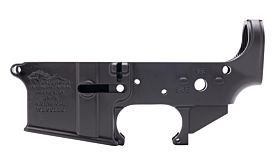What's the Best Upper for Your AR Rifle?
Dec 01, 2020 05:33
With all the effort that people put into their lower receivers, it’s sometimes easy for them to neglect their upper receiver, but that is just as important as the lower, and if you are customising your AR, here is plenty to think about in this area too.

Many consider the lower receiver to be the really important part of the gun because it is the basis of all the other parts – including the upper receiver - to fit onto. It is, quite literally, the centrepiece of the puzzle. But the AR construction is complex, and while pieces might attach to the lower, other parts go on to fit to those too. Make no mistake, the lower is pretty useless without the upper, or indeed, any other part.
Like the Lower, the upper receiver is available in a range of materials and forms. Like lowers, these ‘raw’ forms are forged, billet, or machined material, all of which will have some impact on your final rifle, and will be deciding factors in other areas of your rifle, such a caliber and potential fire rate. Looking to making a rife with a big caliber? Then you are going to want the extra strength and security of the forged material, and accept the price hike that your going to have to shoulder. Building something with a smaller caliber but a pretty high rate of fire?
Then look to the billet-based upper; it’ll cost you less, but will have sufficient inherent strength to breeze through magazines of rounds. If its your first AR build, you might want to play it safe and go for the cheaper option of machined material, just until you have found your customizing feet. Then you can start to think about how much work you want to be doing on your upper.
While your upper is going to connect with your lower to form the main part of your AR rifle, they are available in a number of variations of the basic theme, each needing different levels of added parts (and extra cost) to compete them. These are:
Stripped Upper. Basically, this is just the fully-machined lump of forged, billet, or machined material that goes on to form the upper. Many other parts will need to be added to complete it and make it into the usable assembly.
Assembled Upper. This form comes complete with all relevant parts such the ejection-port door and the forward assist installed. You will still need to buy and add many other parts to make it a usable part of the weapon, but it is a convenient sub-assembly to have around.
Barrelled Upper. This includes the upper receiver barrel, handguard, gas block, and gas tube fitted into place. Barrelled uppers generally don’t include the bolt carrier group or the charging handle. One again, a useful sub-assembly that is convenient to buy as a single assembly.
Complete Upper. This assembly contains all parts discussed as well as the bolt carrier group and the charging handle and is essentially ready to go straight onto the lower receiver to form the finished gun. Many complete uppers may be supplied with ancillary items such as iron sights too. You may be paying more for it, but you have a sub-assembly that can be fitted straight onto your lower receiver and used almost straight away.
What is the best for your build? Like the lower, it depends upon your intended usage. Large calibres and high fire rates may dictate a forged upper, while more casual usage would point to a cheaper, though less rigid, machined upper assembly. Choice constraints are usually price and applied stress.
People may go on about how the lower receiver is the heart of the gun, and all other bits are useless without it. But, in reality, it is no more important than any other piece in this complex upper-receiver assembly that hurls bullets hundreds of yards with accuracy and venom!







































































